In the market since 1.984, HENFEL’s bearing housings are distinguished by their top notch quality. Equipped with an up to date lab with capability to perform chemical, mechanical, metallographic and metrology analysis, the quality management system, which is ISO 9001:2008 certified, monitors the entire process, from the sales, to expedition, hence, contributing to achieve quality excellence.
By means of a close relationship with its costumers that includes focus on the best results for all enterprises involved, HENFEL currently participates of the greatest implantation and expansion industry projects, and direct sales for the aftermarket.
Also, their efficient seal systems guarantee that the life spam of both bearings and shaft are met, reducing the time spent on unpredicted maintenance stops, therefore, they contribute directly with the performance and return of the clients’ investments.
Fill in the fields below to request our contact
HENFEL bearing housings are manufactured out of three different types of materials, depending of the work which they are intended for.:
The description of HENFEL bearing housings suffers alteration according to the specified material, being enough to add the letter in the nomenclature of the bearing, according to table below:
|
MATERIAL |
SAI |
HSBM |
HSBP |
SBPC |
STM |
HSPA |
HSBM30K |
HSBP30K |
SD |
HFR |
SAF |
F500 |
SOFN |
SN30 |
SNH |
HEC |
HF |
|
Grey |
* |
* |
* |
* |
** |
** |
* |
* |
* |
* |
* |
* |
* |
* |
* |
* |
* |
|
Nodular |
N |
N |
N |
N |
* |
* |
N |
N |
N |
N |
N |
N |
N |
N |
S |
N |
N |
|
Cast steel |
S |
S |
S |
S |
S |
S |
S |
S |
S |
S |
*** |
S |
S |
S |
** |
S |
S |
HENFEL’s bearing housings are manufactured in accordance with the most stringent market norms and therefore are in line with existing application standards:
Important remarks:
The seal displayed as standard are used whenever the seal type is not specified by the client. The selection of a seal type depends on a number of given conditions, such as: temperature, circumferential velocity, lubricant type, operation environment, etc.
Upon request, the bearing housings are supplied with other seal types as shown below, classified in three different groups:
The sealing elements have contact with the shaft. Its applications are limited due to the peripheral velocity of the shaft. They are recommended for low speeds and low temperatures.

Information
.jpg)
Information

Information

Information

Information
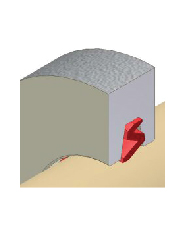
Information

Information

Information

Information

Information

Information
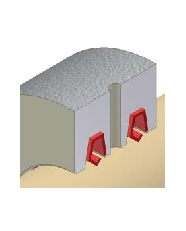
Information
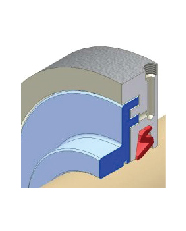
Information
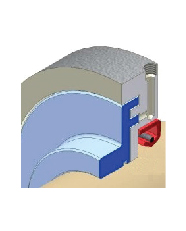
Information
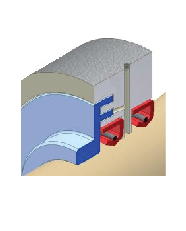
Information
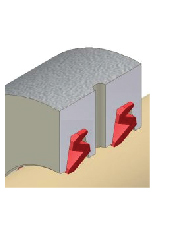
Information
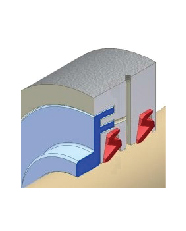
Information
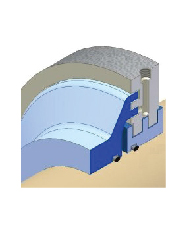
Information
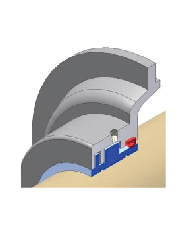
Information

Information
Important remark: The original total width of the housings can be altered when special seals are used instead of the original ones. Please refer to the tables in this catalogue for original housing width dimensions and original seals. We recommend that our engineering division be consulted prior to any request for seals not listed on the dimensional tables.
Capacities shown on the tables below refer to housings made of grey cast iron.
For housings made of nodular cast iron increase displayed values by 80%
Constructive form
As shown on the table below, the bearing housings feature 4 specific constructive forms. In most cases,a “locating bearing” housing must be assembled at the drive side of the equipment in order to avoid the axial displacement of the bearing; a “non-locating bearing” housing must be assembled at the driven side in order to allow shaft axial movements and absorption of small dimensional deviations without straining the mobile parts of the bearings. If more than a bearing housing should be applied to the shaft at the drive side, one of the bearings should be of the locating type, and the others of the non locating type.
BP - Locating bearing, for passing shaft
Non-locating bearing, for passing shaft)
BC – Locating bearing , for blind shaft
LC - Non-locating bearing, for blind shaft
Below, the most common assembling forms are illustrated. The blocking of the axial displacement of the bearing can be done either by a locating ring or by the side covers, depending on the housing series.
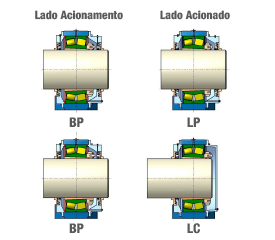
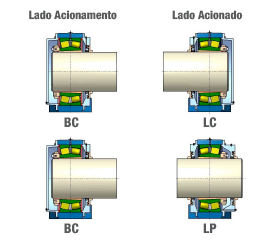
In order to select a contact seal, it is necessary to first know the circumferential velocity of the shaft, which is in contact with the seal. Circumferential velocity is determined as per formula below. Admissible speed for each contact seal is as shown on the catalogue or on this website X through Y.
V = Circumferential velocity, in meters per second (m/s)
N = Shaft rotation, in rotations per minute (rpm)
d = Shaft diameter, in millimeters (mm)
V = (52 x N x d / 1.000.000
E.g.:
d = 200 mm
N = 1200 rpm
V = (52 x 1200 x 200 ) / 1.000.000
V = 12,48 m/s
As it can be seen on the example above, contact seals are not appropriate; we recommend the use of no-contact seals (radial or axial labyrinths).
Lubrication
The purpose of a lubricant is to reduce friction between the moving elements of a bearing and seal and the static elements of the housing, thus reducing internal wear.
The best known and most frequently used lubricants are grease and mineral oil. For each specific application there is an ideal lubricant. For the correct selection of a lubricant various factors should be considered, such as: temperature, environment, operating rotation, bearing type used, etc. The advantages and inconveniences of using grease or oil as well as a practical system for lubricating the bearings inside the housings are given below:.
|
Lubricant |
Advantages |
Disadvantage |
|
Grease |
Ease of warehousing and transport Easy handling and application No need for level control devices Smaller risk of leaking Simple seals It has a sealing effect |
the bearing housing has to be opened up for relubrication Lower rotation limit as compared to oil |
|
Oil |
Higher rotation limit as compared to grease Various lubrication methods Cooling effect on the system. Easy change through drain plugs |
Difficulty of warehousing and transport Difficult handle and application Need for oil level control devices Higher leaking risk More complex seals |
The grease volume applied to the empty spaces of the housing should take into consideration the rotation limit of the given bearing, as indicated on the table below.
|
Fill in all empty spaces of the bearing |
|
|
Rotation |
Grease quantity |
|
Low rotation |
100% |
|
Less than 50% |
50% to 80% |
|
Less than 50% |
30% to 50% |
Recommendations:
As a rule, all grease inside the housing should be replaced every six months.
Quantity of grease to be added at relubrication must be in accordance with the results of the formula below
Where:
G = quantity of grease in grams
D = external diameter of bearing in mm
B = total width of bearing in mm
Ex.: Bearing 22.222 K - ( 110 x 200 x 53 )
G = 0,005 x 200 x 53
G = 53
The specification for housings should be objective, stating as clearly as possible all the manufacturing data. It should contain information on the material used for the housing, type and size of housing, constructive form, seal type, bearing type, shaft diameter, quantity of holes on the base and reference of manufacturer, as per sequence below

|
Material of the housing |
Cast steel - Prefix “S” (except for the SNAH series, which the prefix S stands for nodular cast iron) Nodular cast iron - Prefix “N” (except for the STM and HSPA series, since their standard material is nodular cast iron) Grey cast iron - Prefix omitted |
|
Bearing housing series |
As dimension tables on page 22 onwards. Ex: HSBP 30K, HSBM, etc. |
|
Size of the bearing housing |
See dimensional table of the choosen bearing. |
|
Constructive form |
It refers to the bearing arrangement within the housing and the type of shaft (passing or blind), which will determine the types of side covers that will configure the housing (both opened side covers, or one opened and one closed). See more information on this website or in the catalogue. BP - Locating bearing, with passing shaft; LP - Non-locating bearing, with passing shaft; BC - Locating bearing, with blind shaft; LC - Non-locating bearing, with blind shaft. |
|
Seal |
The seal type to be used should always be indicated. In this catalogue we show various seal types for housings. Below we highlight the most applied. ASR Axial labyrinth and retainer with spring; Felt strips for housings SN, SNA; AS Axial labyrinth; TS Radial labyrinth; TSG Radial labyrinth and GS nitrile retainer; TSR Radial labyrinth and split spring retainer; ASZF Axial labyrinth and retainer ZF; R Retainer; TAS Axial and radial labyrinth; ASRR Axial labyrinth and two retainers with spring. |
|
Shaft diameters |
Shaft diameters or the adapter sleeve used for any housing series should always be specified, especially for housings with contact seals, such as: retainers, labyrinths and others, seeing that each shaft diameter requires its specific seal. |
|
Holes on the base |
The bearing houses type HSBP up to size 20/208/207 can be manufactured with two holes on the base, by means of adding the suffix “D” to the designation: Ex. HSBP-D-16 The bearing houses type HSBM series and SAF-520 up to size 327/328/32 are manufactured with two holes on the base, but they can be manufactured with four as long as the prefix “F” is added to the reference.Ex: FHSBM-16 The opposite is true for housings type SAF. Up to size 520/220/317/617 they are made with 2 holes on the base. When four holes are needed, the prefix “F” must be added. Ex: F-SAF-516. The specification of the number of holes on the base can be added to any housing series on the base. |
|
Bearing |
Even if the scope of delivery excludes the bearings, their exact identification should always be given in order to dimension the locating rings or side covers. |
Specifying HENFEL’s Bearing Housings
Attention: When no specific requests are made, the housings will be manufactured in accordance to their standard, as shown on the dimensional tables of this catalogue, i.e. shafts in millimeters, constructive form LP (non-locating bearing, passing shaft), standard seal and material of the series.
HENFEL produces many housing types for the most diverse uses. The table below contains some of their basic fea¬tures which will help you with the specifications.
The highlighted seals are the original seals of the series.